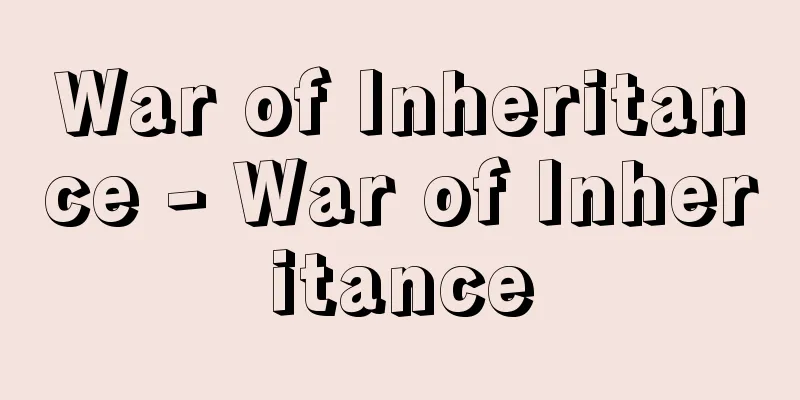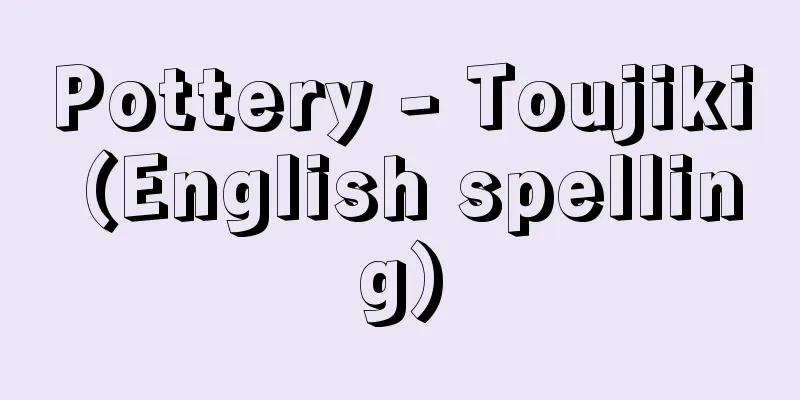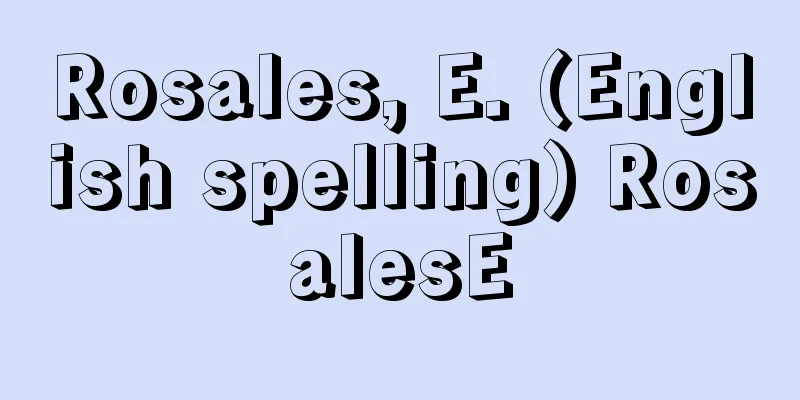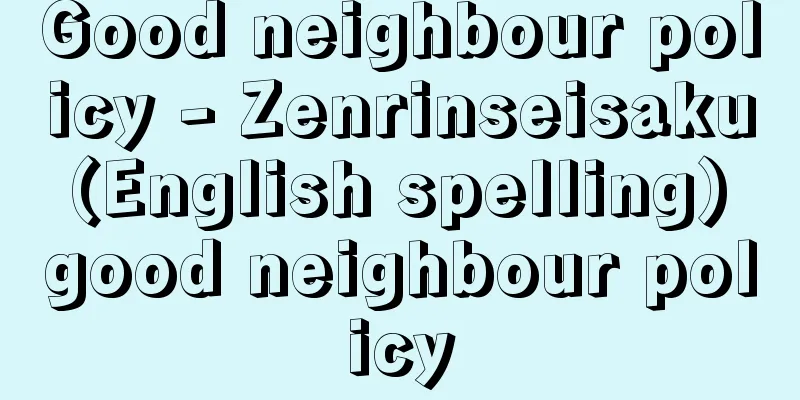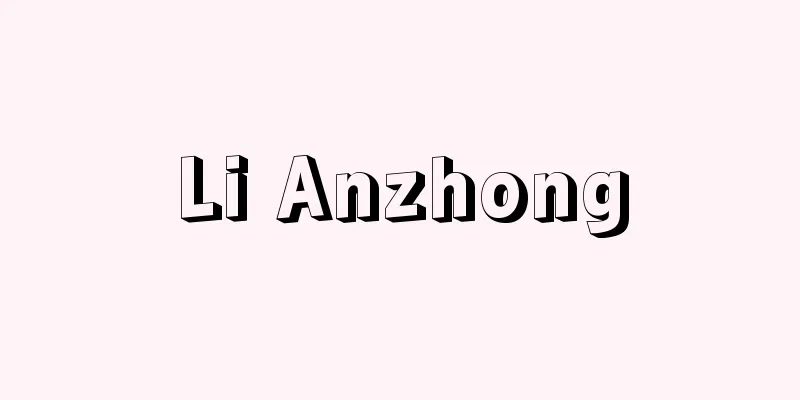Dioxin - Daiokishin (English spelling) dioxine
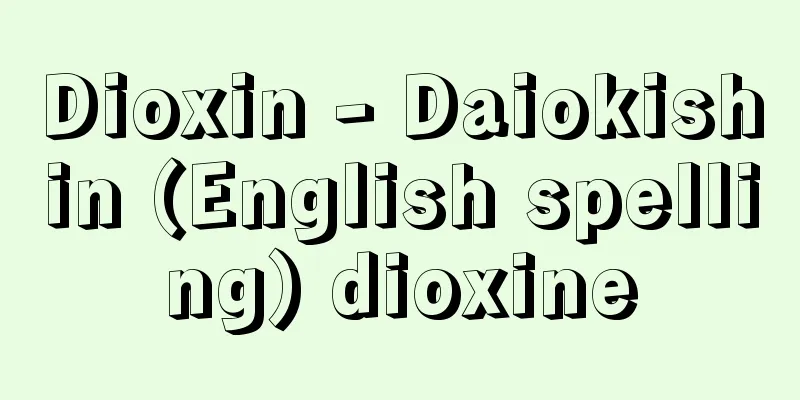
|
A highly toxic organochlorine compound. In the narrow sense, it refers to 2.3.7.8-tetrachlorodibenzo- p (para)-dioxin (2.3.7.8-TCDD, hereafter abbreviated as TCDD). This substance has a molecular structure in which two benzene rings are linked by two oxygen atoms, and four chlorine atoms are bonded to symmetric positions, and is obtained as colorless needle-like crystals. More commonly, the term is used to include dibenzo- p -dioxin isomers (75 types in total) that are bonded to chlorine atoms. [Masatoshi Morita] Dioxins and related compoundsDioxins have a very specific toxicity, which is closely related to their chemical structure. There are 22 types of tetrachlorodioxins, but only 2.3.7.8-TCDD is toxic; other isomers, such as 1.3.6.8-TCDD, are not. This is because only 2.3.7.8-TCDD fits into the Ah receptor like a key and lock, and this acts as a signal to cause a biological reaction. Substances that fit the keyhole include 2.3.7.8-tetrachlorodibenzofuran and coplanar PCBs, which have similar chemical structures. Because such substances share the same mechanism of toxicity, the toxicity of each substance is evaluated by multiplying them by a toxicity coefficient (Toxicity Equivalency Factor, TEF) and calculating the total value (Toxicity Equivalency Quantity, TEQ). [Masatoshi Morita] Sources of dioxins and environmental pollutionThe main sources of dioxins are (1) impurities in industrial chemicals such as chlorinated phenols and related herbicides, PCBs, (2) thermochemical by-products from waste incineration and the recovery of iron and non-ferrous metals, and (3) by-products from chlorine bleaching, etc. According to calculations of emissions from various sources in Japan, the amount of dioxin emissions in 1997 was about 8 kilograms TEQ/year, but with the establishment of the "Law on Special Measures for Dioxins" (Law No. 105 of 1999), the amount of dioxins generated has now been reduced by more than 90%. [Masatoshi Morita] Dioxin toxicity and poisoningDioxin is often called "the strongest poison ever synthesized by mankind," because the lethal dose for guinea pigs is a very small amount, about 1 microgram per kilogram of body weight. The effects of dioxin toxicity vary greatly depending on the species of organism, but in any animal, fetuses and embryos are the most vulnerable to dioxin. Dioxin is a strong carcinogen and a strong teratogen. If a fetus is exposed to small amounts of TCDD during fetal development, it can cause a decrease in sperm count and a decrease in fertility (a state of reproductive function or ability to reproduce). It is also said to slow the development of the brain and nervous system. Dioxins are easily absorbed, but are hardly broken down in the body and are also difficult to excrete, so they tend to remain in the body. Their half-life (the time it takes for a substance taken into the body to be reduced to half) is estimated to be 7 to 11 years, and because the rate at which they are metabolized exceeds the amount newly ingested and accumulated, their concentration in the body increases over a long period of time. Taking into consideration the potential impact of dioxin on future generations, the World Health Organization (WHO) has set an extremely low permissible limit (up to 4 picograms TEQ per kilogram of body weight per day). In 1957, West German dermatologist K. Schultz, who was investigating a skin condition called chloracne caused by 2.4.5-trichlorophenol, identified TCDD, which was present in trace amounts as an impurity in 2.4.5-trichlorophenol, as the causative agent, and this was the first report of dioxin toxicity research. There are many such cases of dioxin poisoning in 2.4.5-trichlorophenol all over the world. Common symptoms of poisoning include skin conditions such as chloracne and melasma that spread throughout the body, as well as a variety of neurological symptoms such as nausea, liver damage, headaches, muscle pain, irritability, and decreased libido. Well-known examples of poisoning due to environmental pollution include Times Beach in the United States, Seveso in Italy, and Operation Bleached Leaves during the Vietnam War. In 1982, a poisoning incident occurred in Times Beach, Missouri, USA, when wastewater from a 2.4.5-trichlorophenoxyacetic acid manufacturing plant was sprayed on a road as a raw material for dust suppressants, resulting in the deaths of more than 60 horses and the poisoning of seven people. In 1976, in Seveso, Italy, a reactor at a 3.4.5-trichlorophenol synthesis plant became too hot, causing a reaction liquid containing TCDD to erupt from a safety valve. Chemical substances carried by a light breeze fell on the town of Seveso, contaminating the area and causing the death or illness of hundreds of animals, including cattle. Most of the people who complained of poisoning symptoms were children, and 135 cases were officially recognized. From 1960 to 1969, the US military sprayed herbicides containing trace amounts of dioxin (Agent Orange, known as Agent Orange in Japan) in the forests of Vietnam under the name of Operation Defoliation. Since then, cases of miscarriage, infertility, and birth of disabled children have been reported, and specimens of disabled children are on display at Tu Du Hospital near Ho Chi Minh City (formerly Saigon). Health problems of soldiers who served in the Vietnam War are also an issue. [Masatoshi Morita] "Poison Dioxin" by Watanuki Reiko (1986, Technology and Humanity)" ▽ "Dioxin 100 Things to Know" by Samaki Takeo, Kuwashima Miki, and Mizutani Hideki (1998, Tokyo Shoseki)" ▽ "Questioning Dioxin Measures from Tokorozawa, the Industrial Waste Ginza" by Saito Tadao (1998, Jichi Kenkyusha) ▽ "Proposal for Emergency Dioxin Measures" by Tachikawa Ryo (1999, Kamogawa Publishing)" ▽ "Dioxin" by Miyata Hideaki (Iwanami Shinsho) [Reference items] | | | | | | |Source: Shogakukan Encyclopedia Nipponica About Encyclopedia Nipponica Information | Legend |
|
きわめて毒性の強い有機塩素化合物の一つ。狭義には、2.3.7.8-四塩化ジベンゾ-p(パラ)-ジオキシン(2.3.7.8-TCDD、以下TCDDと略す)をさす。この物質は、二つのベンゼン環を、二つの酸素原子で結びつけた骨格をもち、四つの塩素原子が対称位置に結合した分子構造をもつ物質で、無色の針状結晶として得られている。より一般的には、塩素原子が結合したジベンゾ-p-ジオキシン異性体(全部で75種)を含めて用いられる。 [森田昌敏] ダイオキシンとその類縁化合物ダイオキシンはきわめて特異な毒性をもち、それはダイオキシンの化学構造と密接な関連がある。四塩化ダイオキシンには全部で22種の異性体があるが、そのなかで毒性があるのは2.3.7.8-TCDDのみであり、ほかの異性体、たとえば1.3.6.8-TCDDには毒性がない。これは、2.3.7.8-TCDDのみがAhリセプターにあたかも鍵(かぎ)と鍵穴のような関係ではまりこみ、それが信号となって、生体反応がおこるためである。 鍵穴にあう物質としては、同じような化学構造をもつ2.3.7.8-四塩化ジベンゾフランやコープラナーPCBなどがある。このような物質は毒性のメカニズムを共有しているために、個々の物質ごとに毒性の係数(TEF、Toxicity Equivalency Factor)をかけて、その合計値(毒性等量TEQ、Toxicity Equivalency Quantity)により毒性の評価を行うことにしている。 [森田昌敏] ダイオキシンの発生源と環境汚染ダイオキシン類の主要な発生源は、(1)塩素化フェノールや関連する除草剤、PCBなどの工業化学品の不純物、(2)ごみ焼却や鉄・非鉄の回収過程などの熱化学的な副生、(3)塩素漂白などに伴う副生、である。日本での各種発生源からの排出量計算によれば、1997年のダイオキシン類の排出量は約8キログラムTEQ/年であったが、その後の「ダイオキシン類対策特別措置法」(平成11年法律第105号)の設置などにより、現在ではその発生量の90%以上が削減された。 [森田昌敏] ダイオキシンの毒性と中毒ダイオキシンはしばしば「人類が合成した最強の毒物」とよばれるが、それはモルモットの半数致死量が体重1キログラムあたり1マイクログラム程度とごく微量であることによる。ダイオキシンの毒性が及ぼす影響は生物の種によって大きく異なるが、いずれの動物においても胎児や胚(はい)がもっともダイオキシンに弱い。 ダイオキシンは強い発癌(がん)物質であり、また強い催奇形性物質でもある。胎児期に微量のTCDDの曝露(ばくろ)を受けると、成熟したあと精子数の減少や妊孕(にんよう)(生殖可能な状態や生殖能力を有する)率の低下をひきおこす。また脳神経系の発達が遅れるとされる。 ダイオキシンは吸収されやすい一方で、体内で分解されることがほとんどなく、排泄(はいせつ)もされにくいことから、体内に残留しやすい。体内半減期(体内にとりこまれた物質が半分に減るまでの時間)は7年~11年と推定され、代謝される速度より、新たに摂取・蓄積される量が勝るため、生体内濃度は永い年月をかけて上昇する。 ダイオキシンが次世代に影響を与えることも考慮して、世界保健機関(WHO)はその許容量としてきわめて低い値(体重1キログラムあたり、1日4ピコグラムTEQまで)を採用している。 2.4.5-トリクロルフェノールに起因する塩素にきび(クロルアクネ)という皮膚症状を調べていた西ドイツの皮膚科医K・シュルツが、そのなかに不純物として微量に含まれているTCDDが原因物質であると同定したのが1957年で、これがダイオキシン毒性研究の最初の報告である。このような2.4.5-トリクロルフェノール中のダイオキシン中毒は世界中で数多い。 中毒の一般的な症状としては、全身に広がるクロルアクネや、黒皮(こくひ)症のような皮膚症状のほか、吐き気や肝障害、頭痛、筋肉痛、神経過敏症、性欲減退など多様な神経症状を示している。 環境汚染による中毒例として、アメリカのタイムズビーチ、イタリアのセベソ、そしてベトナム戦争における「枯れ葉作戦」がよく知られている。1982年にアメリカのミズーリ州タイムズビーチで発生した中毒事故は、2.4.5-トリクロロフェノキシ酢酸製造工場の廃液が埃(ほこり)どめの原料として道路に散布されたために発生し、60頭以上のウマが死に、7人の中毒者を出している。1976年、イタリアのセベソでは、3.4.5-トリクロルフェノール合成工場において、反応器が高温となり、安全弁からTCDDを含む反応液が噴出した。折からの微風により運ばれた化学物質がセベソの町に降ったことにより、地域が汚染され、ウシを含む数百頭の動物が死に、または発病している。人において中毒症状を訴えたのは主として子供であり、135人の患者が公式に認められている。ベトナムでは1960年~1969年にかけて、ダイオキシンを微量含む除草剤(オレンジ剤、日本では枯れ葉剤という名称で知られている)が、アメリカ軍によって「枯れ葉作戦」の名のもとにベトナムの森林にまかれた。その後、流産、不妊、障害児の出生が指摘されており、ホー・チ・ミン市(旧、サイゴン)近郊のツーズー病院には障害児の標本が展示されている。また、ベトナム戦争に従軍した兵士の健康問題も課題となっている。 [森田昌敏] 『綿貫礼子著『毒物ダイオキシン』(1986・技術と人間)』▽『左巻健男、桑嶋幹、水谷英樹著『ダイオキシン 100の知識』(1998・東京書籍)』▽『斉藤忠雄著『産廃銀座・所沢からダイオキシン対策を問う』(1998・自治体研究社)』▽『立川涼著『提言ダイオキシン緊急対策』(1999・かもがわ出版)』▽『宮田秀明著『ダイオキシン』(岩波新書)』 [参照項目] | | | | | | |出典 小学館 日本大百科全書(ニッポニカ)日本大百科全書(ニッポニカ)について 情報 | 凡例 |
<<: Diode - Diode (English spelling)
Recommend
pants
〘noun〙 (pants)① A general term for short pants-sty...
Ring coin - Enkansen
… [Economics of Money] [Definition and Function o...
Kazoku Bank
…The 15th National Bank, whose capital was the no...
Uesugi Shigenori - Uesugi Mochinori
Year of death: April 18, 1919 Year of birth: 1844....
Zen
A plate on which tableware is placed. In ancient ...
Admiralty brass
… Brass improved by adding 0.5 to 2% of additive ...
Quarry - saisekijo (English spelling) quarry
Quarries and stone quarries for the extraction of ...
Huating County
…It is located in the upper reaches of the Huangp...
Gorin
In Confucianism, human relationships are divided ...
Kamimichi Hitatomi - Kamimichi no Hitatomi
Year of death: Jingo Keiun 1.9 (767) Year of birth...
Fruiting body
This refers to the spore-forming bodies of fungi,...
Char, René
Born June 14, 1907 in Porcluse, Lille-sur-Sorgue [...
Kingdom of Caucasian Albania - Kingdom of Caucasian Albania
An ancient kingdom located in southern Dagestan in...
Pahlava
… [Susumu Sato] 【India】 A branch of the Parthians...
Himeeboshi (Princess Eboshi) - Himeeboshi (English spelling) Poecilasma kaempferi
A crustacean of the family Ploceidae in the order ...



